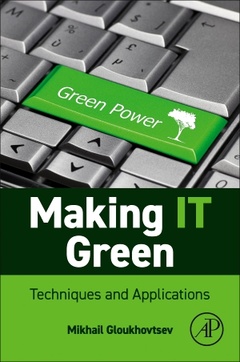Making IT Sustainable Techniques and Applications
Auteur : Gloukhovtsev Mikhail

Implementing sustainability solutions in Information Technology (IT) or broader ? in Information Communications Technology (ICT) - is a challenge but it is essential. The goal of Making IT Sustainable: Techniques and Applications is to show how it has been done, strategies, various solutions, tool sets, and best practices. Various IT areas are investigated ? from data center technologies and operations to cloud computing, to green software, to cryptocurrency, to the transformative AI role in making IT sustainable, to quantum and adiabatic computing. The adoption of sustainable IT practices reduces the environmental footprint of IT by advocating for the utilization of renewable energy sources, electronic waste reduction, the design of energy-efficient IT devices, innovative cooling technologies, and circular economy. Sustainable IT is a complex and challenging field. As a result, there are many questions and uncertainties about how to implement sustainable practices across various scenarios. Making IT Sustainable: Techniques and Applications asks several insightful questions: How can environmentally sustainable data centers be built? How do we compare the carbon footprint of data centers versus public cloud, and cloud-focused IT sustainability standards? How can quantum computing be made environmentally friendly? How to make cryptocurrency mining sustainable? Are the economic costs of sustainable IT prohibitively higher than society is willing to bear? Transformative role of AI in making IT sustainable is reviewed. Readers of Making IT Sustainable: Techniques and Applications will be a very diverse group. First, the readers include IT professionals who are responsible for managing and maintaining IT infrastructure and systems. The book can provide them with knowledge and guidance on how to reduce the environmental impact of their IT operations. Second, business leaders making decisions about the use of IT will find guidance in the book on how to implement sustainable IT practices in their organizations. Academics and researchers interested in the field of sustainable IT will find information and data helping them develop new ideas and innovative approaches to IT sustainability. The goal of IT sustainability is to contribute to making our planet better. Therefore, students who are interested in pursuing careers in IT or sustainability are the most important members of the book audience. The book helps them understand the key role of sustainability in IT and develop skills and knowledge in this field. Overall, everyone who is interested in reducing the environmental impact of IT can benefit from this book on sustainable IT, regardless of their professional background or level of expertise. Making IT Sustainable: Techniques and Applications is written by an IT practitioner actively working in the field of sustainable IT. The author has firsthand knowledge of the challenges and opportunities of implementing sustainable practices in IT operations. Readers will find practical solutions with examples of their implementations.
2. IT Sustainability: Definitions, Terminology, Standards & Metrics
3. Technologies and Innovative Solutions for Sustainable Data Centers
4. Green and Sustainable Software Engineering
5. Cloud: Sustainability as a Driver of Cloud Technology Innovations
6. Sustainable High Performance Computing
7. Roles of 5G/6G and IoT in Advancing IT Sustainability
8. Circular Economy and Sustainable IT
9. Remanufacturing Programs in Sustainable IT
10. Sustainable IT Supply Chain Management and IT Procurement
11. The Environmental Implications of Remote Working
12. Cryptocurrency and Its Impact on the Environment
13. Adiabatic Reversible Computing
14. How Quantum Computing Contributes to Achieving Sustainable IT
15. Transformative Role of AI in Making IT Sustainable
Mikhail Gloukhovtsev is an Enterprise Cloud Architect in Kyndryl Consult US. He is an industry-recognized SME in cloud computing, multi-cloud expert working on IT service strategy, design, and implementation of cloud solutions. As a result of Mikhail’s academic and industry career, he possesses a unique confluence of knowledge and experience in both chemistry and information technology, making him exceptionally qualified to author an insightful book on achieving environmental sustainability in the realm of IT. Mikhail holds a Ph.D. in Computational Chemistry (his citation h-index=40 in December 2023) reflecting a strong scientific foundation and commitment to research excellence and an expert level cloud architect certifications: Microsoft Certified Azure Solutions Architect Expert, AWS Certified Solutions Architect Professional, and Google Cloud Certified Architect Professional.
With award-winning publications illustrating industry leadership, Mikhail contributes an informed vision to steer IT practices toward environmental sustainability This expertise, coupled with his experience as an information technology practitioner, positions Mikhail at the intersection of two critical domains that are pivotal for addressing sustainability challenges in IT. His interdisciplinary background and multifaceted capabilities make Mikhail well-equipped to delve into the intricacies of this subject and offer valuable insights.
- Presents various initiatives to address IT sustainability, looking at approaches for improving energy efficiency in IT such as Adiabatic Reversible Computing, use of direct current, and dematerialization
- Focuses on the design of sustainable IT systems and aims to be solution oriented
- Reviews innovations in software development that contribute to GHG emission reductions such as Rust programming language
- Investigates innovations in data center technologies, green software, adiabatic reversible computing, and cloud computing
Date de parution : 06-2024
Ouvrage de 302 p.
15x22.8 cm
Thèmes de Making IT Sustainable :
Mots-clés :
IT Sustainability; Data Center infrastructure Efficiency; Power Usage Effectiveness; Adiabatic Reversible Computing; Green and Sustainable software; Server Power Management; Embodied energy; Green Storage Initiative; Direct current power distribution systems; Use of Microgrids for Data Centers; High-Performance Computing; 5G/6G and IT Sustainability; IoT and Energy Savings; Environmental impact of Cryptocurrency; Quantum computing; Climate change
